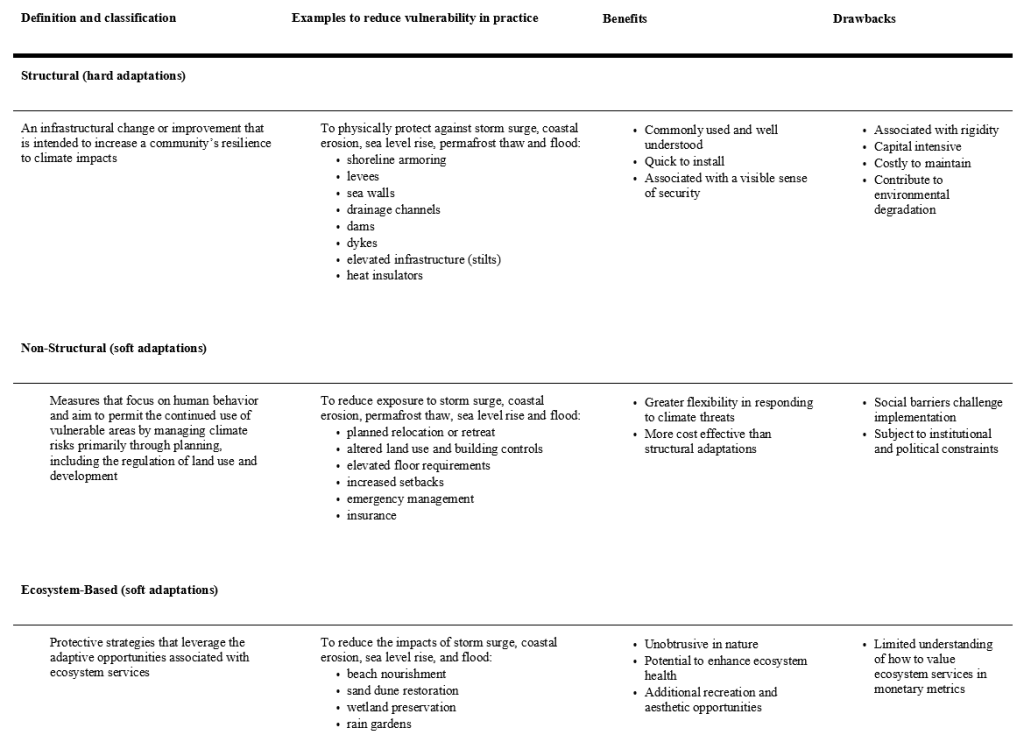
Adaptation planning: An interdisciplinary approach to climate change risk reduction
– By Sarah Kehler, S. Jeff Birchall-
Climate change presents a complex and unprecedented problem. As temperatures rise, the global climate is becoming increasingly unstable. Climate impacts, such as sea level rise and frequent extreme weather events, are causing acute impacts on ecological and human systems. Although climate change is a global phenomenon, unique and severe consequences occur at the local level. Uncontrollable coastal erosion, devastating overland flooding or atypical temperature extremes can easily overwhelm an unprepared community. Climate impacts are likely to be costly: in 2025, Canada is expected to see a loss of $25B due to climate change, and by 2100, annual losses could be as high as $100B (Sawyer et al, 2022). These risks underscore the importance of adaptation, the process through which communities anticipate and prepare for climate change
Unique and intensifying local climate impacts are forcing communities to adapt. With their place-based knowledge and authority, local governments, such as municipal and regional governments, are in an ideal position to facilitate this adaptation (Birchall et al., 2023). Urban planning guides local-level decision making around future land use, development and infrastructure. Adaptation planning seeks to integrate climate science into urban planning – a critical step toward preparing for climate change. Decision making that considers future projections can considerably reduce disaster risk, enhance infrastructure resilience and prepare communities for uncertainty (Davoudi et al., 2013).
Anticipatory adaptation provides security. Adaptation mitigates disaster risk and, should an event occur, can substantially reduce response costs and economic losses. In fact, every $1 spent on anticipatory adaptation will provide up to $15 benefit within 75 years (Sawyer et al, 2022). However, the benefits of adaptation go beyond economics. Adaptation, when implemented equitably, provides food and livelihood security, increases human health and well-being, and conserves biodiversity.
There are two main types of adaptation: hard adaptation and soft adaptation (Table 1). Hard adaptation is structural, focusing on updating infrastructure to withstand climate impacts. Today, most adaptation consists of hard infrastructure measures like sea walls (Kehler & Birchall, 2021). Soft adaptations are non-structural or ecosystem-based, focusing on managing risks through restricting land use and bolstering ecosystem services. Soft measures are increasingly recognized as critical aspects of adaptation; flood risk, for example, can be mitigated through wetland preservation or zoning restrictions.

Adapting effectively requires sufficient adaptive capacity – the conditions that enable communities to anticipate and respond to change (Cinner et al., 2018). Local governments must be flexible, cooperate across jurisdictions, and understand the importance of adaptation (Birchall et al., 2023). They must have access to resources, such as money, technology or services, in order to initiate adaptation. Public support, stakeholder engagement and political leadership underpin adaptive capacity; without people advocating for anticipatory action, adaptation is unlikely to occur (Ford & King, 2013). There is growing awareness that implementation of adaptation is often inequitable, with wealthy areas receiving greater support, decreasing the overall adaptive capacity of the community (Kehler & Birchall, 2021).
Adaptation is not a cure-all for climate change. Both hard and soft adaptations come with limits, benefits and drawbacks (Table 1). However, over-reliance on hard adaptation has put communities at risk: Climate change will quickly outpace our capacity to adapt through hard measures alone. Despite good intentions, over the long-term hard adaptation can carry high maintenance costs and risks of failure, while providing less benefits than soft adaptation (Birchall et al., 2022). In some circumstances, the unintended consequences of expensive infrastructure and engineered adaptations can lead to maladaptation, when adaptation measures do not decrease risk, and rather increase vulnerability to climate change.
Unfortunately, many communities, overwhelmed by the sheer cost and magnitude of future adaptation demands, lack the consistent public support and bureaucratic efficiencies necessary to meet them (Birchall et al., 2023). These barriers can inhibit the planning process from undertaking effective local-level adaptation, and increase the risk of maladaptation (Kehler & Birchall, 2021). Avoiding maladaptation requires effective and equitable adaptation. To do so, planning must address adaptive capacity constraints and aim to balance hard and soft adaptations. These goals can be achieved simultaneously. For example, by exploring less expensive and minimally disruptive soft options first, communities can avoid maladaptation risks, garner public support and conserve limited resources for when hard measures are unavoidable.
Case study: The challenge of adaptation in the Canadian Arctic

While climate change is impacting communities across the globe, the Canadian Arctic currently experiences intensified local-level climate impacts. Recent studies find that, since 1979, arctic amplification has caused northern regions to warm nearly four times faster than the global average (Rantanen et al., 2022). This intense warming has caused substantial physical impacts, such as permafrost thaw, sea ice loss, coastal erosion and biodiversity loss. Isolation, ecological fragility and remoteness further render northern communities vulnerable to climate change.
Extreme exposure to climate impacts require intensive adaptation. However, Arctic communities face unique adaptation barriers and maladaptation risks. Many of these barriers and risks remain unknown due to lack of technical data and personnel, and inadequate public consultation. As climate change worsens, it is becoming apparent that hard and soft adaptations typically used in warmer climates have little utility in the Arctic. Extreme cold narrows ecological niches, reducing biodiversity and constraining the feasibility of ecosystem-based adaptation. Simultaneously hard infrastructure adaptation is limited by structural and ecological fragility, and maladaptation often leads to widespread environmental degradation. As a result, infrastructure maintenance and upgrades are becoming increasingly expensive, which communities struggle to afford due to low property values. When infrastructure goes unmaintained, disaster risk increases and northern communities, which tend to be isolated and reliant on a single economic industry or subsistence food production, are vulnerable to even minor disruptions (Birchall et al., 2022).
For Arctic communities adaptation is complex. Indigenous knowledge systems are crucial to effective adaptation, and may offer insight into current unknowns. However, as mindset barriers and inequality prevent collaboration, high proportions of marginalized groups can restrict effective adaptation (Kehler & Birchall, 2021). Collaboration between Indigenous communities and local governments is necessary to overcome barriers and co-create effective long-term adaptation policies (Birchall & MacDonald, 2019). Adaptation in the Canadian Arctic offers a unique opportunity to address lagging reconciliation and set an example for integrating non-western knowledge systems into disaster risk reduction.
Sarah Kehler is currently a PhD student at the University of Alberta; her general area of study is Urban and Regional Planning. She is currently a research assistant with the Climate Adaptation and Resilience Lab, focusing on barriers to achieving equitable and effective policy for adaptation and resilience to climate change.
S. Jeff Birchall, PhD, RPP, MCIP is an Associate Professor of Local-scale Climate Change Adaptation/ Resilience, in the School of Urban and Regional Planning, Department of Earth and Atmospheric Sciences, University of Alberta, where he serves as Director of the Climate Adaptation and Resilience Lab. Jeff leads the UArctic Thematic Network on Local-scale Planning, Climate Change and Resilience. Further questions regarding the article can be directed to jeff.birchall@ualberta.ca
adaptation planning, climate adaptation, climate change, climate resilience, jeff birchall, sarah kehler, university of alberta
